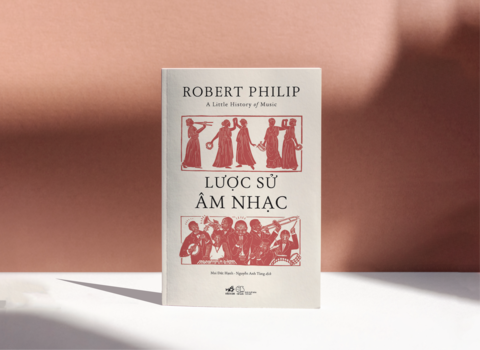The History of Music by Robert Philip is a profound research work that combines multiple approaches and fields of study, offering readers a comprehensive understanding of the nature, role, and historical development of music.
The 40 chapters of The History of Music guide the reader from the primal forms of music to when humans began using music for worship, chanting, and meditation; through the rise of musical instruments and orchestras; and onwards to when music stirred revolutionary thoughts in people's minds, eventually reaching modern times and the future direction of music.

The book is published by The World Publishing House and Nhã Nam.
The Shadow of an Ancient Time
Music has deep roots in the natural instincts of humans. Even before birth, a child can sense rhythm through the heartbeat and breathing of the mother. Upon birth, infants can already respond to meaningful sounds and melodies at an early age.
Many tasks from ancient times, such as digging, rowing, pulling ropes, and striking stones, created musical inspiration due to their characteristic rhythms. This demonstrates the close connection between music and everyday human activities.
It is from these rhythmic sensations that humans began to use natural materials to create sounds, starting with simple instruments like bone flutes found in German caves to more complex instruments like the lyre in Mesopotamia and Egypt. The development of musical instruments not only reflects technological advancements but also underscores the significant role of music in the cultural and religious life of ancient civilizations.
An Era of Music Developing Alongside Humanity
Music is not only an art form but also a complex social phenomenon. It reflects social structures, power relations, and societal changes.
Music developed in various directions within different cultures. In religious ceremonies, music played a crucial role as a means of connecting humans with the divine.
In Asia, particularly in China, music is closely tied to rituals, philosophy, and is a tool for meditation and intellectual development. In Western culture, the development of music is closely associated with the church and religion. In Africa, music is deeply connected to the community and daily life.
While each culture has its own distinct characteristics in music, there are commonalities in how music is used as a means of communication, expression, and community connection.
The Rapid Development that Confirmed the Position of Music
Above all, this is a book that offers a concise history of music. Therefore, Philip dedicates many pages to analyzing the formation and development of music across different periods. He meticulously analyzes how music transcended borders, influencing different groups of people and cultures throughout various periods.
Robert Philip focuses particularly on analyzing the strong development of music in the modern era, in various aspects, and how music is closely linked to social, cultural, and technological factors.
With the advent of convenient recording technologies, the popularity of music has far surpassed what humans could have imagined. Newer, easier-to-play instruments led to an increase in the number of bands associated with the military, town governments, and factories.
In people's lives, music also became deeply embedded in family and social environments. The piano became a popular instrument in middle-class families, especially considered suitable for educating women and young girls in music.
The development of music during this period is also intertwined with the emergence of new cultural and ideological movements.
Notably, the cultural exchange between musical traditions and the role of music contributed to the promotion of social equality. In the 1960s, music played a vital role in the Civil Rights Movement in the United States. The cultural exchange through music was significant, with Black and White artists beginning to appreciate and learn from one another. In the performing arts, many female artists courageously broke barriers to gain recognition. Though it was not easy, this shows that music has the power to transcend racial and gender barriers, even in the most tense periods.
Condensing all of the vast content above into a book with the humble title of "A History," Philip leads readers on an incredibly engaging journey through every form of music, with all its variations, within the broad context spanning across history.
Translated by MINH KIÊN
VNQD